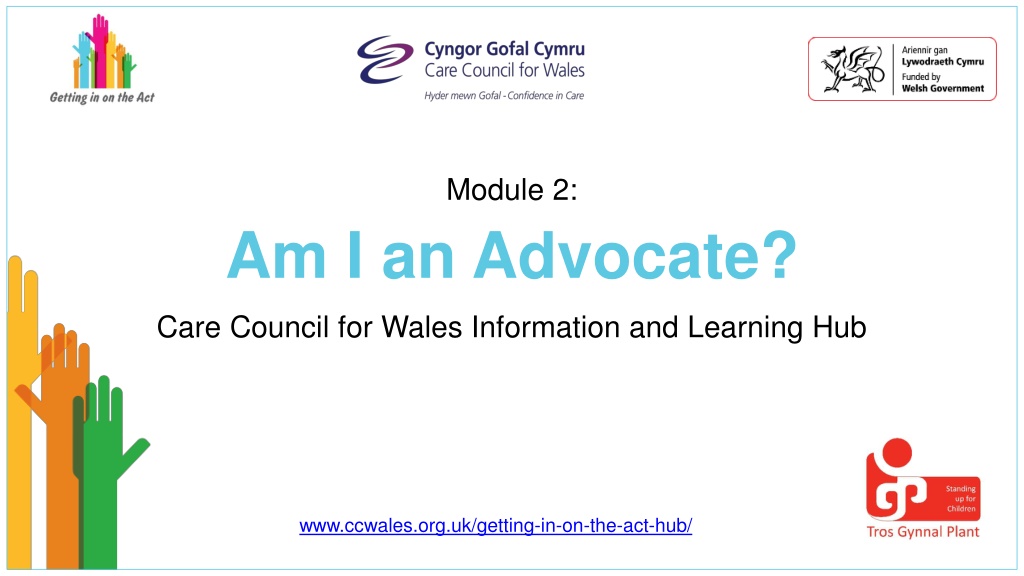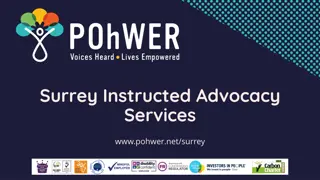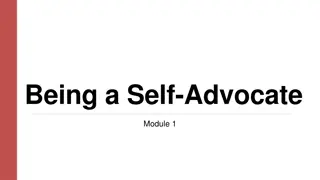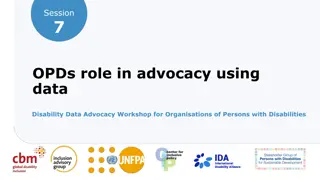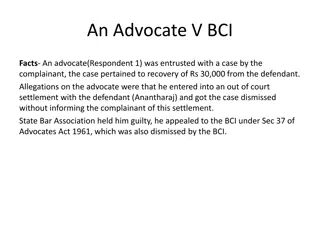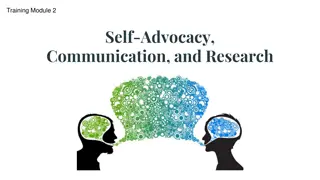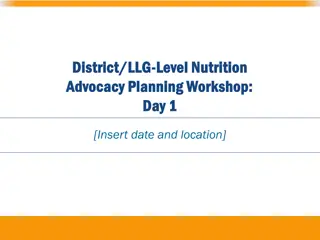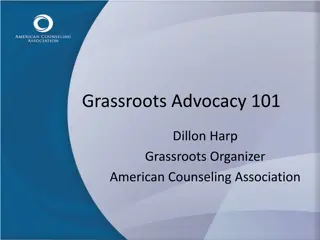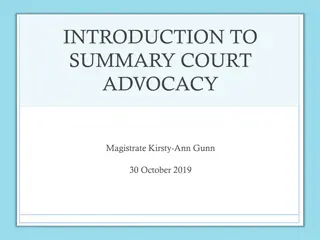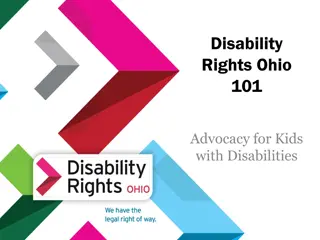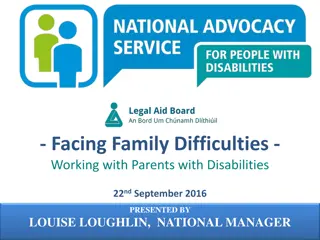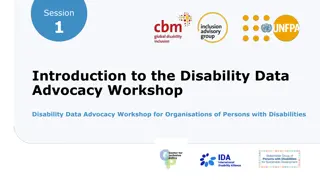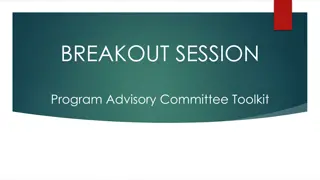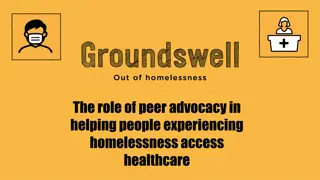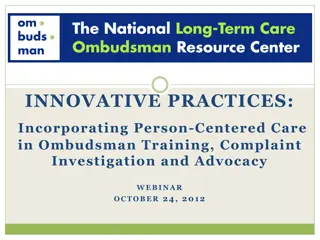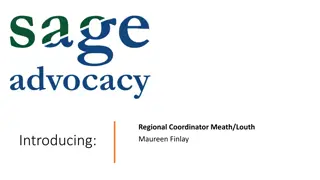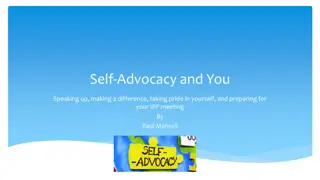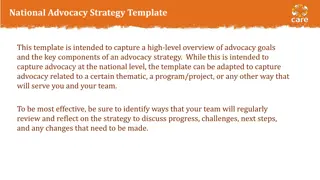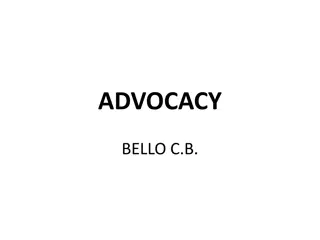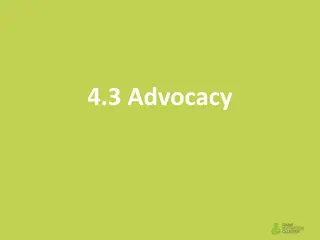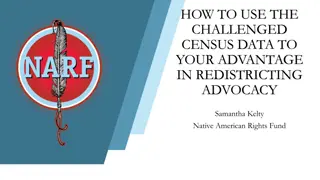Understanding Advocacy: An Overview of Being an Advocate
Explore the concept of advocacy, learn how to act as an advocate effectively, identify alternative options when unable to advocate, and support others in having a voice through activities and exercises outlined in the session. Understand the types of advocacy, including formal, peer, and informal advocacy roles.
Uploaded on Oct 07, 2024 | 0 Views
Download Presentation

Please find below an Image/Link to download the presentation.
The content on the website is provided AS IS for your information and personal use only. It may not be sold, licensed, or shared on other websites without obtaining consent from the author. Download presentation by click this link. If you encounter any issues during the download, it is possible that the publisher has removed the file from their server.
E N D
Presentation Transcript
Module 2: Am I an Advocate? Care Council for Wales Information and Learning Hub www.ccwales.org.uk/getting-in-on-the-act-hub/
Learning outcomes for this session By the end of the session learners will be able to: Identify when and how they themselves may act as advocates Understand why they may be unable to advocate effectively in some situations Know what alternative options are available to ensure that the person receives ongoing support if they are unable to advocate effectively
The Squeaky Wheel I hate to be a kicker, I always long for peace, But the wheel that does the squeaking, Is the one that gets the grease. (Josh Billings, c1870)
What is advocacy? Advocacy is Advocacy is not An advocate must Representing a person s wishes and feelings. Counselling. Be led by the person only doing what they request. Ensuring a person s rights and entitlements are being met. Support work. Represent what the person wants, regardless of their own opinions. Accessing information to ensure the person understands the process. Befriending/mentoring. Consult with the person throughout. Helping a person consider their options. Advising a person on what you think is best for them. Help the person consider all their options. Attending a meeting with someone to give them more confidence. Representing a person against their wishes. Have the time to participate as much as requested by the person. Listening to a person and acting on their direction. Talking about someone behind their back and knowing things they don t. Be friendly while still maintaining boundaries.
Exercise 2: How do we support others to have a voice and be heard? 1. Hearing their story clarifying the issue 2. Helping them access accurate information 8. Making positive endings when the advocacy relationship ends 3. Establishing what their preferred outcome is 7. Helping them understand outcomes 4. Helping them explore options including processes involved in each 6. Helping them tell others what they want 5. Helping them decide what they want, including all potential outcomes
Recap advocacy types Formal advocacy Some broader professional roles have an element of advocacy within them. The professional can support the individual to express their views and wishes while separately expressing their own professional views or judgements. Peer advocacy An individual might look for advocacy support from someone who understands their situation because they ve been there or are in similar circumstances to themselves. Informal advocacy An individual may seek advocacy support from someone they know on an informal basis. This type of advocacy forms part of a broader emotional relationship where the advocate may have their own strong feelings about what s best for the individual. Independent Professional Advocacy An individual may be able to access an advocate whose job is to provide them with independent support to get their voice heard regardless of their own views or opinions of the situation.
Examples of advocacy Peer advocacy advocating that a work colleague should be entitled to the same amount of breaks as you. Informal advocacy advocating that your child wishes to move schools to be able to study a particular subject they are interested in. Formal advocacy advocating that someone you provide care to is not happy in their accommodation, at their request. Professional/Independent advocacy working for an advocacy service and advocating for a young person at a review meeting.
Barriers to being an effective advocate No one type of advocacy is best The reasons why each type of advocacy may/may not be suitable to the situation can be: 1) Linked to the person needing advocacy 2) Linked to the person potentially providing advocacy 3) Linked to the issue or situation
Deciding what not to do is as important as deciding what to do. Steve Jobs Co-founder, Apple Inc
Barriers to advocating effectively Being personally involved in the situation Not having the time Not being able to fully understand or communicate with the person Conflict of interest with own position and not being able to be independent
What can we do if were unable to advocate? Is there anyone else in a similar role that could advocate? Is there another form of advocacy available? Meic 0808 802 3456 www.meiccymru.org Citizens Advice 0345 404 0506 www.citizensadvice.org.uk Older People s Commissioner 02920 445030 www.olderpeoplewales.com Children s Commissioner 0808 801 1000 www.childcomwales.org.uk Is the person eligible to receive Independent Professional Advocacy support? (Specific to their situation)
Independent Professional Advocacy Local authorities must arrange for the provision of an independent professional advocate when a person can only overcome the barrier(s) to participate fully with assistance from an appropriate individual, but there is no appropriate individual available.
Learning outcomes for this session By the end of the session learners will be able to: Identify when and how they themselves may act as advocates Understand why they may be unable to advocate effectively in some situations Know what alternative options are available to ensure that their advocacy partner receives ongoing support if they are unable to advocate effectively
